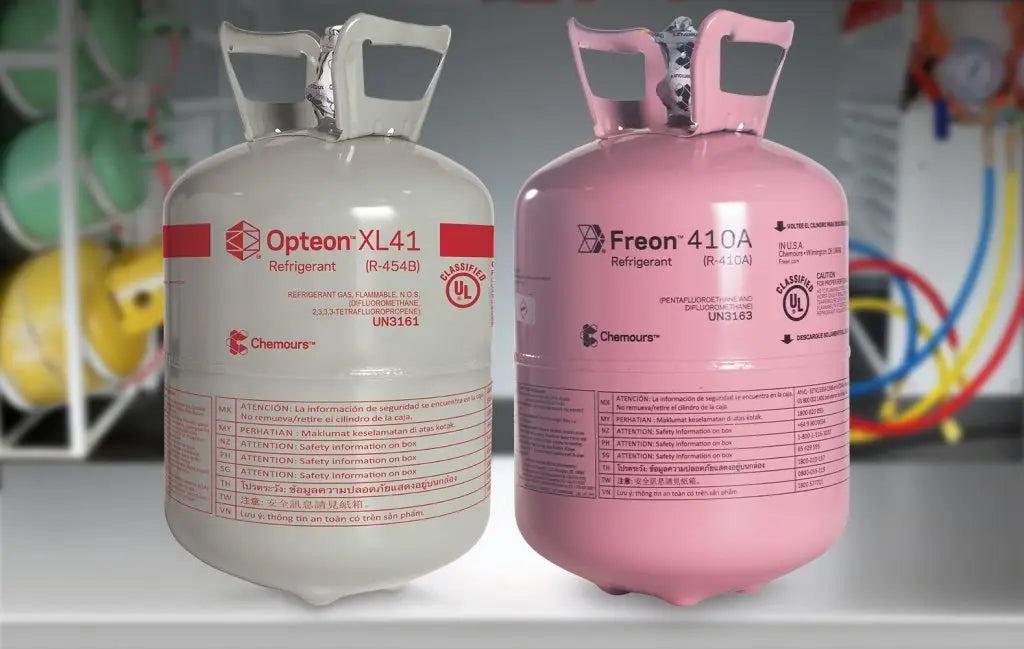With the HVAC industry in the midst of a refrigerant transition, homeowners and contractors alike are hearing more about A2L refrigerants. These new refrigerants—such as R-32 and R-454B—are becoming mandatory in many systems sold after 2024. But what exactly is an A2L refrigerant, and why does it matter for your home HVAC setup?
This guide explains what A2L means, how it compares to older refrigerants, what safety precautions are required, and how you can prepare your home for the future of air conditioning and heating.
🧪 What Does “A2L” Mean?
A2L is a classification developed by ASHRAE and used globally to rate refrigerants based on their toxicity and flammability:
-
“A” = Low toxicity
-
“2L” = Mildly flammable (lower flame speed than typical flammable gases)
This distinguishes them from older refrigerants like R-410A (A1: low toxicity, no flammability) and highly flammable types like propane (A3).
Though mildly flammable, A2L refrigerants are designed to be safe in properly installed systems, and their use is already widespread globally.
🌎 Why Are A2L Refrigerants Replacing R-410A?
The shift to A2L refrigerants is driven by environmental regulations, including the AIM Act, which phases down the use of hydrofluorocarbons (HFCs) with high Global Warming Potential (GWP).
| Refrigerant | GWP | A2L Status | Use Phase-Out | Replacement |
|---|---|---|---|---|
| R-410A | ~2,088 | No | By 2025 (U.S.) | R-32, R-454B |
| R-32 | 675 | Yes | No | Yes |
| R-454B | 466 | Yes | No | Yes |
A2Ls strike a balance between environmental responsibility and performance, offering much lower GWP than previous options while still maintaining safe usability.
🔥 Are A2L Refrigerants Safe?
Yes—with proper installation and maintenance. A2L refrigerants are classified as “mildly flammable,” meaning they require specific conditions (high concentration + ignition source) to combust.
According to Daikin, R-32 has been installed in over 160 million systems worldwide with no widespread safety issues when installed according to code.
Safety Protocols Include:
-
Leak detection sensors in some environments
-
Enhanced ventilation requirements
-
Fire safety-rated equipment rooms (in commercial installs)
-
Use of non-sparking tools and components
🧰 How A2L Systems Differ from Legacy Systems
Installation Differences:
-
Technician Certification: Contractors must be trained in A2L refrigerants and safety handling
-
Permits: Some areas require fire and mechanical permits for A2L installs
-
Recovery Equipment: New reclaim and recovery systems are needed
Homeowner Experience:
From the end user’s perspective, day-to-day operation is virtually the same. You’ll see similar or improved efficiency, quieter operation, and in many cases, better smart control integration.
⚙️ Which A2L Refrigerant Is Best for Residential HVAC?
Two main A2L refrigerants dominate the residential space:
🔹 R-32
-
Single-component: Easier to service and reclaim
-
Used in over 160M units worldwide
-
Higher energy efficiency
🔹 R-454B
-
Blend refrigerant: Requires liquid charging and complex handling
-
Lower GWP than R-32, but harder to service
-
Used by OEMs seeking the lowest GWP
For most homeowners, R-32 offers the best balance of performance, safety, and cost. See our full breakdown on R-32 vs R-454B here.
🧮 Will A2L Equipment Cost More?
In general, yes—initial costs may be 5–15% higher due to:
-
Technician training premiums
-
Specialized tools and safety components
-
Limited market availability during transition
However, this is offset by energy efficiency savings and better long-term serviceability, especially with R-32 units.
🏠 How to Prepare Your Home for A2L Equipment
1. Hire a Certified HVAC Contractor
Ensure they have experience with A2L installations and understand updated code requirements.
2. Check Permit Requirements
Contact your local building department for any special zoning or safety permits.
3. Get a Load Calculation (Manual J)
Proper sizing ensures efficiency and reduces risk of refrigerant leaks or improper pressure handling.
Learn more about Manual J sizing from HVAC.com.
✅ Conclusion: A2Ls Are the Future of Cooling
A2L refrigerants like R-32 and R-454B are here to stay. Their adoption is driven by environmental goals, but the benefits for homeowners are clear: better efficiency, future-proof technology, and more precise climate control.
While mildly flammable, these refrigerants have an impressive safety record and are already in use globally.
By working with knowledgeable contractors and staying informed, homeowners can confidently invest in systems that use A2L refrigerants—and help the planet while staying cool.
Need help deciding between refrigerants? Explore our full comparison: R-32 vs. R-454B: Which A2L Refrigerant Is Better?







